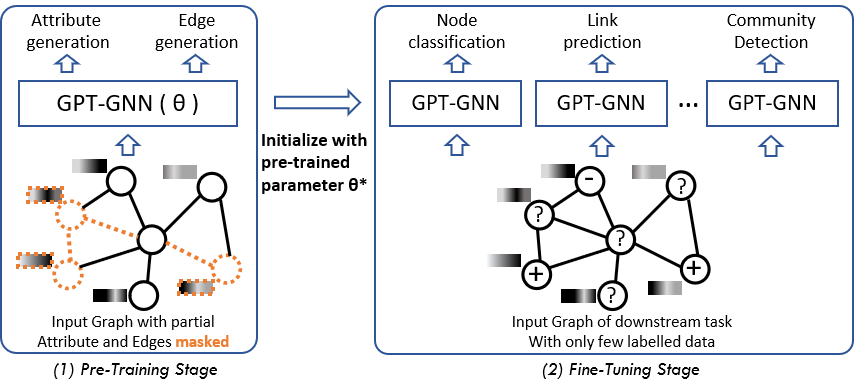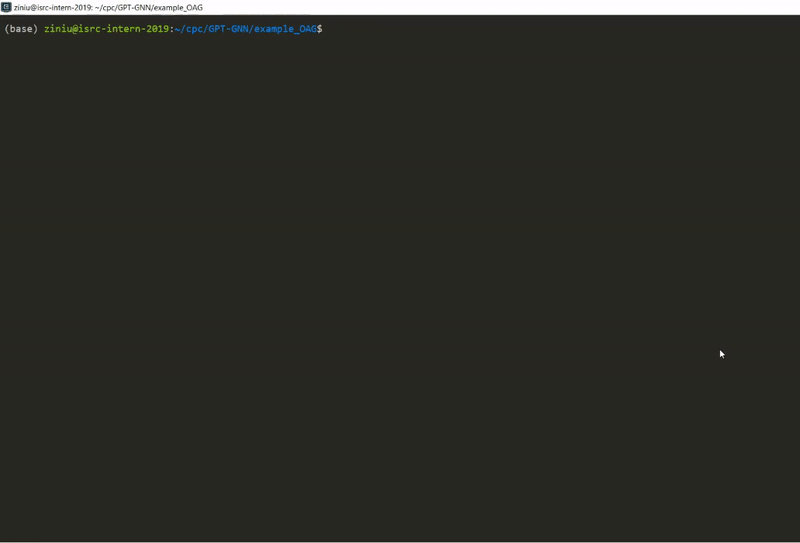GPT-GNN is a pre-training framework to initialize GNNs by generative pre-training. It can be applied to large-scale and heterogensous graphs.
You can see our KDD 2020 paper “Generative Pre-Training of Graph Neural Networks” for more details.
The key package is GPT_GNN, which contains the the high-level GPT-GNN pretraining framework, base GNN models, and base graph structure and data loader.
To illustrate how to apply the GPT_GNN framework for arbitrary graphs, we provide examples of pre-training on both hetergeneous (OAG) and homogeneous graphs (reddit). Both of them are of large-scale.
Within each example_* package, there is a pretrain_*.py file for pre-training a GNN on the given graph, and also multiple finetune_*.py files for training and validating on downstream tasks.
For Open Academic Graph (OAG), we provide a heterogeneous graph containing highly-cited CS papers (8.1G) spanning from 1900-2020. You can download the preprocessed graph via this link. We split the data by their time: Pre-training ( t < 2014 ); Training ( 2014 <= t < 2017); Validation ( t = 2017 ); Testing ( 2018 <= t ). As we use the raw-text as attribute generation task for OAG, we provide a pre-trained word2vec model via this link.
If you want to directly process from raw data, you can download via this link. After downloading it, run preprocess_OAG.py to extract features and store them in our data structure.
For Reddit, we simply download the preprocessed graph using pyG.datasets API, and then turn it into our own data structure using preprocess_reddit.py. We randomly split the data into different sets.
This implementation is based on pytorch_geometric. To run the code, you need the following dependencies:
- Pytorch 1.3.0
- pytorch_geometric 1.3.2
- torch-cluster==1.4.5
- torch-scatter==1.3.2
- torch-sparse==0.4.3
- gensim
- sklearn
- tqdm
- dill
- pandas
You can simply run pip install -r requirements.txt to install all the necessary packages.
We first introduce the arguments to control hyperparameters. There are mainly three types of arguments, for pre-training; for dataset; for model and optimization.
For pre-training, we provide arguments to control different modules for attribute and edge generation tasks:
--attr_ratio FLOAT The ratio (0~1) of attribute generation loss . Default is 0.5.
--attr_type STR type of attribute decoder ['text' or 'vec'] Default is 'vec'
--neg_samp_num INT Whether to use layer-norm on the last layer. Default is False.
--queue_size INT Max size of adaptive embedding queue. Default is 256.
For datasets, we provide arguments to control mini-batch sampling:
--data_dir STR The address of preprocessed graph.
--pretrain_model_dir STR The address for storing the pre-trained models.
--sample_depth INT How many layers within a mini-batch subgraph Default is 6.
--sample_width INT How many nodes to be sampled per layer per type Default is 128.
For both pre-training and fine-tuning, we provide arguments to control model and optimizer hyperparameters. We highlight some key arguments below:
--conv_name STR Name of GNN filter (model) Default is hgt.
--scheduler STR Name of learning rate scheduler Default is cycle (for pretrain) and cosine (for fine-tuning)
--n_hid INT Number of hidden dimension Default is 400.
--n_layers INT Number of GNN layers Default is 3.
--prev_norm BOOL Whether to use layer-norm on previous layers. Default is False.
--last_norm BOOL Whether to use layer-norm on the last layer. Default is False.
--max_lr FLOAT Maximum learning rate. Default is 1e-3 (for pretrain) and 5e-4 (for fine-tuning).
The following commands pretrain a 3-layer HGT over OAG-CS:
python pretrain_OAG.py --attr_type text --conv_name hgt --n_layers 3 --pretrain_model_dir /datadrive/models/gta_all_cs3The following commands use the pre-trained model as initialization and finetune on the paper-field classification task using 10% of training and validation data:
python finetune_OAG_PF.py --use_pretrain --pretrain_model_dir /datadrive/models/gta_all_cs3 --n_layer 3 --data_percentage 0.1- The 3-layer HGT model pre-trained over OAG-CS under Time-Transfer Setting via this link
- The 3-layer HGT model pre-trained over Reddit via this link
Please consider citing the following paper when using our code for your application.
@inproceedings{gpt_gnn,
title={GPT-GNN: Generative Pre-Training of Graph Neural Networks},
author={Ziniu Hu and Yuxiao Dong and Kuansan Wang and Kai-Wei Chang and Yizhou Sun},
booktitle={Proceedings of the 26th ACM SIGKDD Conference on Knowledge Discovery and Data Mining},
year={2020}
}This implementation is mainly based on pyHGT API.

